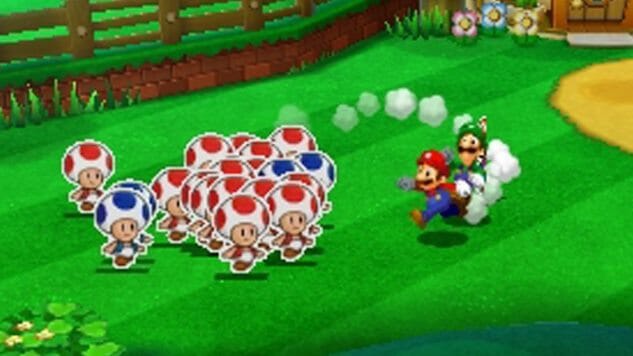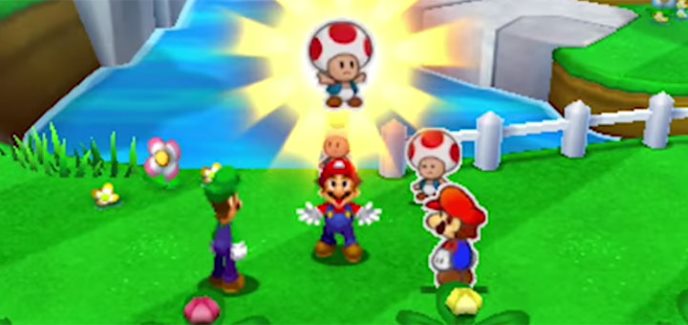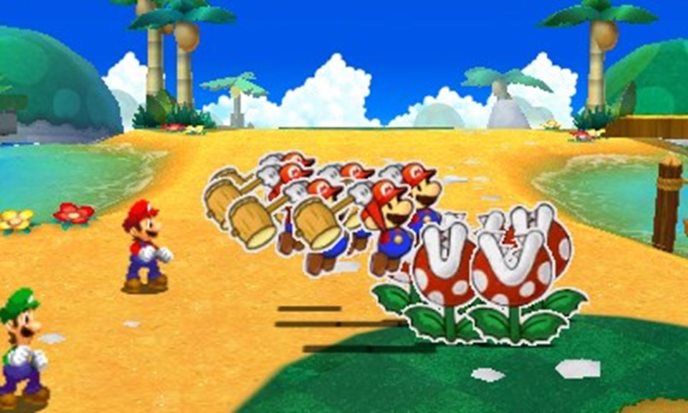
You know who they are. You’ve seen them before. Goombas, Toads, Koopas. Princesses in pink dresses and spiked-shell mutant turtles. And the heroes, color-coded plumbers with soup strainers and the power to throw fire. The one difference? Some are flat, and some are not.
The reliance on classic Mushroom Kingdom characters at first appears stale to those who have played earlier Mario role-playing games, especially those games starring dynamic one-off weirdos like Geno and Fawful. But sticking to the mainline familiars lets Nintendo do a special thing in this unexpected mash-up: Allow the flattened doppelgängers from the world of Paper Mario confront those from Mario & Luigi for the first time.
What happens when a Paper Princess meets the real deal? An early joke even capitalizes on the distinction: “What does real even mean?” a Toad asks quietly, before moving on with the story. The player is left to ponder the semantics of identity. Meanwhile, expectations continue to topple.
Whereas recent forays like Paper Mario: Sticker Star threw out nearly all traditional RPG rules such as leveling up your experience, Paper Jam retains that still-satisfying progression from weakling to brute. And though this new version maintains conventions expected in a traditional role-playing game—towns filled with info-giving villagers and monsters stalking an overworld—it adds a great number of required excursions to the formula.
At times, the result feels like that most dreaded of genre subheadings: “minigame collection.” The quest is waylaid time and again in order to do something completely different: Find fifteen Paper Toads hidden in the scenery; battle foes without your normal actions, relying only on self-defense; sneak around Shy Guys with binoculars without being spotted.

The variety of tasks helps keep the monotony of a normal role-playing game at bay. But it’s tough to shake the feeling that the hodgepodge of game types weakens Paper Jam’s identity as it flips from one kind of experience to another. In the west, “RPG” isn’t even in the title, though it is in Japan, where it’s called Mario & Luigi RPG: Paper Mario Mix. But instead of a focus on standard free-roaming exploration, Nintendo and developers AlphaDream have delivered on something closer to an action-puzzle grab-bag.
Depending on your interests, these sidelines will either deepen your enjoyment of the overall experience or cause great frustration, keeping you from the battle/leveling-up feedback loop that hooks so many RPG veterans. Paper Jam does intertwine its story beats with these diversions, if thinly, so that it never feels wholly arbitrary. And if you can get on-board with the paper-versions of fictional characters run amok in a fantasy land conceit, there’s plenty of fun reveals and twists to be had.
Luigi continues to be the butt of a hundred jokes. But at least his new sidekick is happy to console him: Seeing that Luigi is crying due to losing a special item, Paper Mario folds into a napkin. Luigi takes the Mario napkin and dries his eyes, after which the living tissue squeegees himself out and pops back into Mario form. These small details make the world an inviting one to stumble across. And new abilities are doled out consistently, giving you a bevy of tools with which to poke and prod your surroundings.
One element new to this sequel is the use of a giant papercraft version of a character. He (or she) is rolled out and you engage in something close to sumo wrestling against giant papercraft enemies. Again, the love is in the details. At first glance you appear to be moving via wheels or tank treads; look more closely and your papercraft giant stands atop a platform held up by a dozen Toads. The 3DS bottom-screen is an overhead map, and you have to pummel enough giant Goombas and some boss enemy such as Kamek the magician to clear the stage.
Once you do, the action stops and the line “CLEARED” flashes on the screen, before jumping back to the normal view. Immersion isn’t necessarily the hallmark of a good Mario game; our participation requires an outsized capacity for pretending. Keeping these seams visible is a part of the package.

Paper Jam could have benefited from even more transparency. Boss Battles come with no warning, which are a fun surprise until you understand you can’t save, you haven’t saved for thirty minutes, and you’re likely going to lose the first time through. Even if you manage to eke out a victory, the labor involved should come with an epidural; these fights take a long, long time, and with no health bar to watch dwindle, you’re left punching a wall with little feedback.
More successful are the standard overworld battle. Landing a simple attack never loses its satisfaction. Special moves offer a whimsical flair. A simple face-off becomes a destructive papier-mâché racquetball match. Another instance knocks the enemy flat, attaches it to a kite, after which the brothers take turns racing forward, raising the kite higher into the air, before Paper Mario runs up the line and hammers down the foe through the clouds onto the ground. A six-step process turns into a miniature cartoon play, if only for a splash of major damage. Over time, though, these same complicated procedures turn even regular battles into slogs that take way too long.
What surrounds these fights is worth the time investment. You can tell the designers are having fun. After a fierce battle, a giant caterpillar named Wiggler “takes a nap.” He’s just tired, he says, closing his eyes. Soft piano music plays. Winged Goombas swoop down and take him up above the screen. The bros. are all crying, tears streaming from their eyes like water fountain spray. Then a voice from above calls out, “Why’re you so sad?” It’s Wiggler, newly turned into a butterfly, who then flies you off to the next area.
This happens more than once, where a darkness seeps out only to turn out lighter than expected. Other RPGs that are meant to be taken seriously can suffer from the inherent problems of an interactive medium; a scene’s emotional weight doesn’t always translate when your chosen actions don’t align with the moment. A landscape of flimsy monsters and spiky-haired protagonists makes affecting drama even more difficult. But here, where the very title of the game promises a paper-thin premise, these segues into faux-sadness, even if it’s all for a lark, are more effective than their melodramatic counterparts.
Yoko Shimomura is largely to thank for our held attention. She’s the composer, and has written most of the music for the Mario & Luigi series. With the deep roots of its title characters, you’d expect too many dips into nostalgic remix territory, but Shimomura has carved out her own path and given the games their own memorable sound. It makes sense that the soft piano music interlude mentioned above is so touching; Shimomura studied as a pianist at the Osaka College of Music. (She’s also known for Street Fighter II and Kingdom Hearts soundtracks, which underscores the mix of elements at play in Paper Jam: one part battle music, one part character mash-up adventure.)
Good thing the music is so inviting; you’ll be asked to listen for longer than necessary. But for all the fatigue I often felt and frustration that left me feeling crumpled, I keep wanting to dive back in. Paper Jam leads you to an unsuspecting slaughter, only to make the slaughtered feel vindicated, good even, wishing to be ramshackled again and again. There’s something about this series of Mario role-playing games that defies reason. I should have disliked the game for all the times it unfairly punished me or took too long or explained something unnecessarily. Yet I never folded.
Maybe it’s the personality of our voiceless, gesturing heroes. Not once does Luigi or Mario, Paper or otherwise, say a word. They rant and rave, gesticulating with fluidly animating limbs and elastic faces, and those in the game-world understand. But we the player have to watch, waiting for the interpretation. It’s an antiquated stubbornness in 2016 to still have silent protagonists. But it turns what could have been just another fantasy storyline into something closer to a puppet show. We, rapt by these figures on sticks, know it’s all malarkey but can’t wait to see what happens next. Even if—especially because?—we know they’re all just cardboard and glue.
Mario & Luigi: Paper Jam was developed by AlphaDream and published by Nintendo. It is available for the 3DS.
Since 2003, Jon Irwin has been paid to write about film, techno, ice cream, wine, golf, drag-racing, French children and videogames. His first book, Super Mario Bros. 2, was published last year by Boss Fight Books. Follow along: @WinWinIrwin.